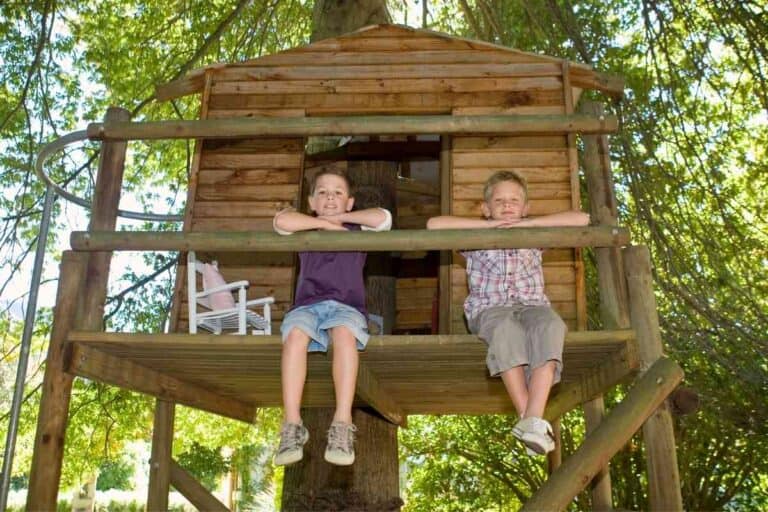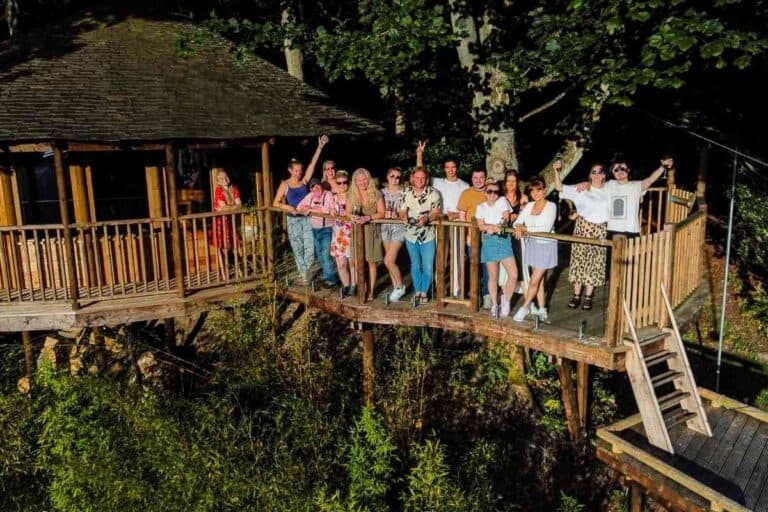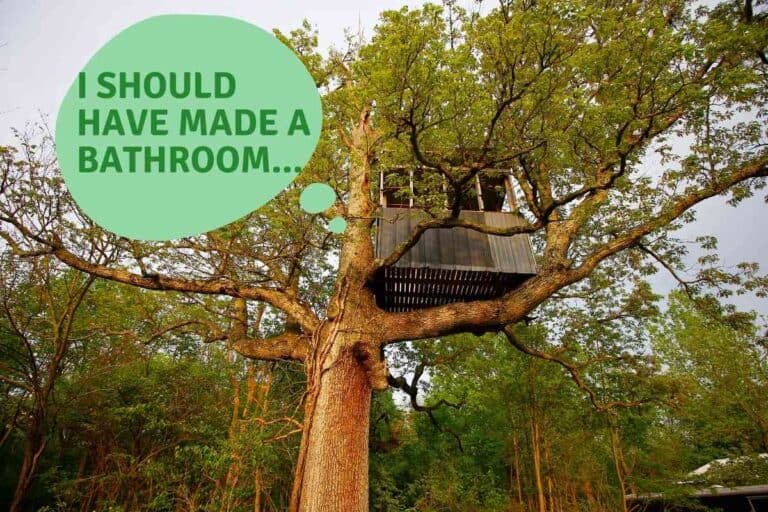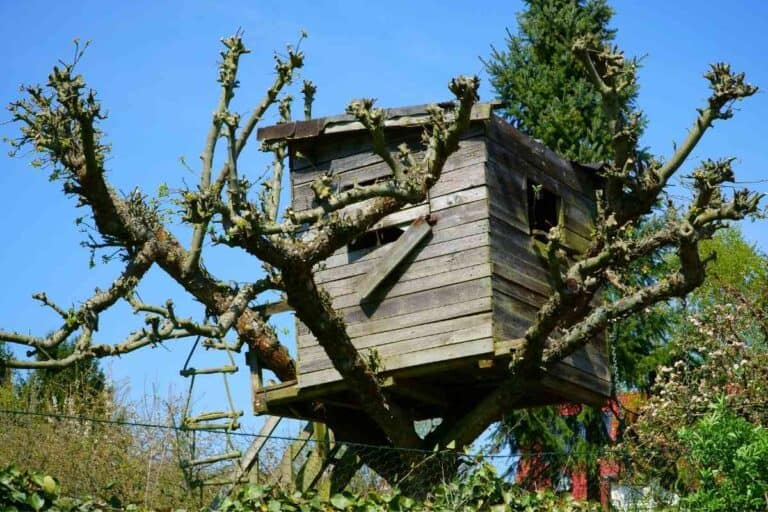How-To Build a Treehouse for Under $100
Treehouses are a fun backyard feature. And that fun comes at a high price. Adding a treehouse to your property will typically cost at least $1000. But what is there was a way to drastically reduce that expense?
Although challenging, it is possible to build a treehouse for under $100. To do this, a homeowner needs to provide their own labor, limit the size of the treehouse, and build with the least expensive materials available.
Are you interested in completing an exciting project without breaking the bank? Read on to learn the most cost-effective way to build a treehouse.
Cost Cutting Principles for Building a Treehouse
Later on, we will cover seven steps for building a treehouse. But first, let’s prime ourselves to think in the most cost-effective way.
Considering our goal of building a treehouse for under $100, we will need to approach each step with a frugal mindset. Below are some of these best principles to keep in mind when trying to build a treehouse at the lowest possible price.
- Use your own labor
- Simplify your design
- Find inexpensive materials
Employ a cost-saving mindset. By remembering the tips above, you will be better able to find opportunities to save money as you work through this project.
Use Your Own Labor
Perhaps the most obvious way to cut costs on treehouse construction is to do the work yourself. The cost of hiring someone else alone will likely put you over your $100 budget.
Gather some friends who are willing to help you with the project. It seems unlikely that someone would work for no pay. But you might be surprised to find that many of your friends would be happy to take on a fun weekend project.
By collaborating with neighbors and acquaintances, you have the chance to share both labor and tools. This can go a long way in saving you money.
The fact that you will be doing the work yourself is why we will cover treehouse building basics. Follow these steps and don’t do anything you are unsure of.
The most important aspect of any project is safety. Use good tools and techniques to protect your body and maintain your health as you work.
Simplify Your Design
Following a simple design is less likely to result in high costs. Simple designs are also easier to build.
Along with simplicity, you should also consider the size. Of course, the larger your treehouse is, the more materials you will need. The more materials you need, the more you will likely spend to acquire them.
Benefits of Simple Design
- Smaller size equals lower materials cost
- Simple forms result in easy construction
- Basic shapes reduce the need for specialized tools and skills
Focus on functionality rather than extravagant features. This will reduce both the cost and overall construction time for your treehouse.
Find Inexpensive Materials
The last tip for minimizing the cost of your treehouse is to get creative in your search for materials. You can always purchase your materials at the nearest store, but be on the lookout for the least expensive options.
Below is a table with some of the most inexpensive building materials you can use for your treehouse.
| Material | Application | Price |
| 2 “X8” Lumber | Platform Joists | $14/8’ |
| 2” X2″ Lumber | Framing | $2/8′ |
| Oriented Strand Board | Flooring and Roofing | $ 21/4’X8′ Sheet |
Alter the size of your treehouse based on the pricing above until you are under $100. Keep in mind that you will also need tools and hardware to fasten these materials together.
But assuming that you will provide your own tools and labor, wood is really the only purchase you will need to make. Since you are prioritizing low cost, you will have to make some sacrifices related to aesthetics.
For example, oriented strand board (OSB) is not the most attractive wood on the market. Because it is unfinished, it is also not the best for painting.
On the plus side, OSB is strong and resistant to moisture damage. This makes OSB a great option for both your flooring and your roofing.
Look for Free Lumber
The only option better than low-cost lumber is free lumber. Believe it or not, there may be an opportunity for you to get your lumber for no cost at all. Below are some of the most common sources of free lumber
- Lumber yards – Lumber yards often have a scrap pile. This is wood that is no longer useful to the lumber company. Often, if you haul it, you can take this lumber off their hands for free.
- Construction Sites – When construction crews tear down old buildings, they may be discarding lumber that is perfectly suitable for your treehouse. Speak with the construction supervisor and ask if you can take some of the lumber off their site.
- Neighbors – If your neighbor is throwing out old furniture, you may be able to find good materials for your treehouse. Just because your neighbor doesn’t want it doesn’t mean that this wood is a bad building material. But always ask before removing anything from someone else property.
Before spending a single dollar on materials, check the sources listed above. You may be able to find the majority of your building materials for little to no cost at all.
Choosing the Right Materials for a Treehouse
As you seek the least expensive way to build your treehouse, you still need to adhere to safe practices. At no point does reducing cost outweigh the priority of structural integrity.
Don’t be so thrifty that you end up endangering future treehouse users. To maintain safety, follow the guidance below.
- Don’t use broken or rotted wood – This wood is weak and not suitable for building. If you use this kind of wood, you are asking for trouble. Your treehouse will likely deteriorate much faster than normal. In the worst-case scenario, it may collapse while someone is in it.,
- Choose wood that will last -Your treehouse is open to the elements. You need to choose materials that will hold up in all types of weather. We’ll talk more about this in a bit.
- Keep weight in mind – Unlike other buildings, treehouses must be lightweight. This is because you don’t want to force the tree to carry an unnecessary amount of weight. Excessive weight increases the odds that the tree will break, and your treehouse will be destroyed.
Hardwood vs. Softwood
There are two broad categories of lumber available to you.
- Hardwood
- Made from slower-growing trees
- Stronger wood
- More Expensive
- Softwood
- Made from faster-growing trees
- Lighter wood
- Less Expensive
There is a time and place to use each of these types of wood. While hardwood is more durable, it is heavier and more expensive. This is not ideal for a treehouse for two reasons.
- First, you want to limit the weight you are placing on the tree. Hardwood will add unneeded weight.
- Second, hardwood is not worth the cost. Especially when you are trying to build for under 4100, you want to use the less expensive softwoods. Pine, for example, is a commonly used softwood in construction.
How to Build a Tree House
You can’t face the challenge of building a treehouse for under $100 if you don’t know the basics of building one in the first place. Below are seven steps you should follow when building a simple treehouse.
- Choose a quality tree
- Design your treehouse
- Build a platform
- Establish structural support
- Install decking
- Add walls and roof
- Provide access
Choosing the Right Tree
The backbone of a treehouse is, of course, the tree itself. As a first step, select a tree that is sturdy. You should have no doubt that the tree you choose can hold multiple people.
Generally, you want a tree that appears healthy and strong. There are a few species that are better suited for this role.
- Oak
- Maple
- Hickory
Hardwoods, like the trees listed above, are usually your best option. Softwoods are more likely to bend sway and break. This poses a significant danger to anyone in your treehouse.
Design Your Treehouse
Don’t start building without having a clear vision of your final product. Out of haste, many people tend to skip this set.
But the smartest way to complete any construction project is to put pencil to paper first. This may end up saving you time and money later on.
Remember that your drawings don’t need to be artistic. They are only meant to help you organize your ideas.
Your drawings also serve as a reference for you as you build. You don’t want to run into problems hours into construction that could have been solved from the beginning.
Build a Platform
The platform is the first part of the treehouse you should build. This will support your flowing and the rest of your treehouse structure.
The platform will also support you and anyone else using the treehouse. Because of this, you need to be careful as you build your treehouse platform.
Follow good construction techniques to make sure your platform is structurally sound. This will help to ensure that your treehouse is safe to use.
Establish Structural Support
The treehouse platform holds you up, and the supports hold the platform up. As such, you need to carry the same attention to detail into this step of the building process.
Good supports are another vital source of stability for the structure of your treehouse. There are two ways of building treehouse supports.
- Tree connection – Supports are fastened to the trunk of the tree
- Ground connection – Supports connect to the ground
If you choose a ground connection, consider building your treehouse at a lower height. This will help to reduce the total amount of wood you will need.
Install Decking
Now that your treehouse as achieved a level of stability, it is time to make it a bit more usable. The first step in this process is to add decking.
The decking or flooring is the surface people will walk on when in your treehouse. This flooring will be fastened directly to your platform.
Look for materials that will provide a smooth, consistent finished surface. This will make it easy to walk in your treehouse without worrying about tripping.
Again, OSB is your best bet for flooring. Even though there are far more aesthetically pleasing woods available, OSB is inexpensive and reliable.
Add Walls and Roof
At this point, your treehouse has strong support and level flooring, but it remains far from complete. Next, it is time to add walls and a roof to your treehouse.
These elements are what make your treehouse more than just a raised platform. They add a sense of enclosure and safety. Without them, your treehouse would have little to no protection from the weather, and it will be dangerous to use.
There are two components to your treehouse walls: the framing and the finished wall surface.
Framing
The framing is the structure of your wall. Since you want your treehouse to be lightweight, you can opt for smaller lumber pieces than you would use for framing walls in your house.
The least expensive option is 2″ X2″ lumber. This is another pint where you will need to balance structure and cost.
The more lumber you use in framing, the stronger the frame will be. Naturally, this will raise costs. But that doesn’t mean you can’t be efficient with your materials. Frame your treehouse with the least amount of wood that will still maintain a sturdy structure.
Finished Wall Surface
The second wall component is your finished surface. This will be connected to the framing and cover the openings between the framing lumber. At the risk of producing a bland treehouse, you can use OSB again for your finished wall surface.
The exact shape of your treehouse is yours to choose. Just remember that opting for a smaller size and a simple shape will help you reach your goal of minimizing cost.
Provide Access
By now, it looks like your treehouse is complete. But there is one critical part missing. Even if your treehouse is stable and looks the way you want, you still need a way to get in.
There are a few good options to provide access to your treehouse.
- Ladder
- Rope ladder
- Climbing rope
- Cargo Net
The most common way to get into your treehouse is via a ladder. The lumber you used to build your treehouse frame will be suitable for building a ladder as well.
The least labor-intensive way to provide access to your treehouse is to simply attach a rope. However, this means of access is the hardest to use, especially for little ones.
It takes significant strength to climb a rope. But rope may be all that your budget allows. If so, this is just another argument for building your treehouse low to the ground.
What Is Your Treehouse Missing?
Up until now, we have focused only on cost. The guidance above will help you to build a barebones treehouse for the least amount of money.
Perhaps later on, you will find some funds you wish to use to enhance your treehouse. When that happens, here are some interesting features you can add to your treehouse to make it a bit more interesting.
- Windows
- Slide
- Swing
- Porch
Windows
Adding windows is a great way to improve your treehouse. You can always cut holes in your walls when framing to create a window-like opening. But a real window is made of glass.
Including glass windows will let your treehouse users look outside while still being fully protected from the elements.
Slide
Remember when we discussed how to build a way to get into your treehouse? Well, there are fun ways to get out as well.
A slide can be easily attached to your treehouse. This feature will only add to the fun for any children using your treehouse.
Swing
Like the slide, a swing will make your treehouse that much more enjoyable for kids. Luckily, swings are not all that difficult to construct.
For a simple and fun feature, consider making a tire swing. Provided that there is enough room, this type of swing can hang below your treehouse connecting directly to the platform.
Porch
The construction sequence we described assumes that when you are in your treehouse, you will be surrounded by floor, wall, and ceiling. But some of the best treehouses have outdoor sections as well.
To build a porch, you will need to expand your platform so that the flowing can extend beyond the confines of your wall. The added weight means you will need more support
Also, you will want to add an exterior railing. This is a critical safety feature for anyone standing on your treehouse’s porch. Without a railing, there is nothing stopping someone from falling off the platform.
Conclusion
Kids and adults love treehouses. As you shop for one, remember that with a little bit of elbow grease, you can have a treehouse in your yard for less than $100.
While this is a challenge, there are just a few guiding principles to keep in mind. Find inexpensive materials and friends willing to help you. With a little hard work and thrift, soon you will have a treehouse your whole family can enjoy.

![How Do Treehouses Stay Up? [The Unobvious Answer!]](https://freedomresidence.com/wp-content/uploads/2022/05/How-Do-Treehouses-Stay-Up-1-768x512.jpg)




![Are Treehouses Dangerous? [How To Avoid Injuries!]](https://freedomresidence.com/wp-content/uploads/2022/05/Are-Tree-Houses-Dangerous-768x512.jpg)